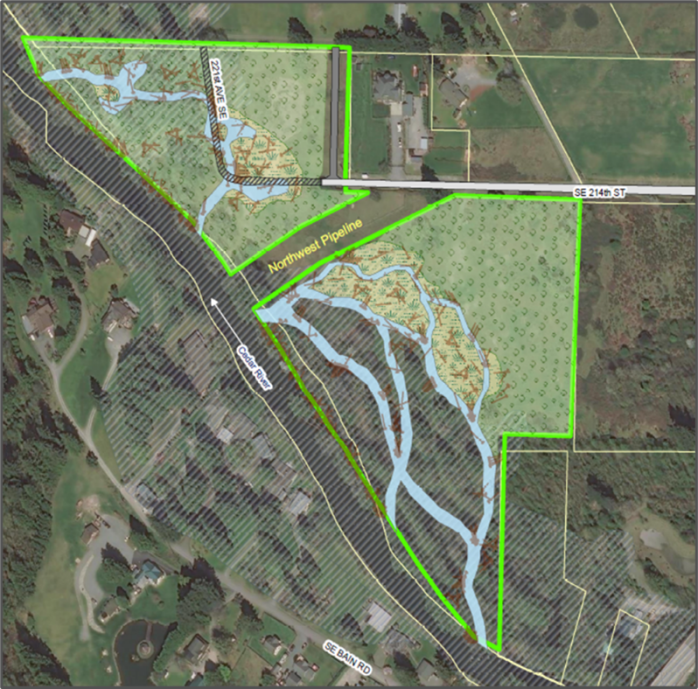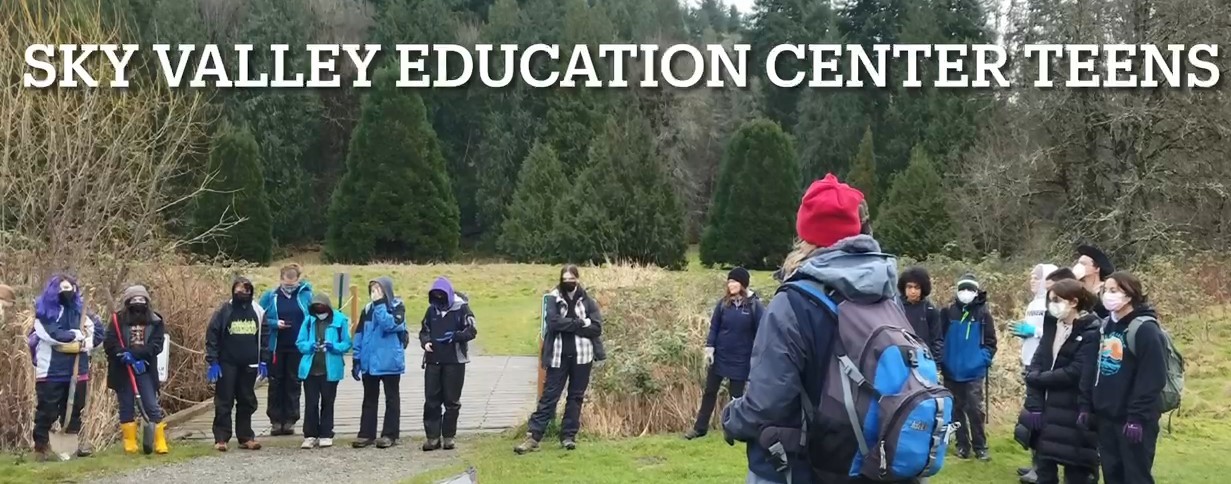|
Bear Creek - An Oral History of a Changing Landscape
Gary Smith has been on the WRIA 8 Salmon Recovery Council as a community organization representative for 15 years. With the help of many partners, he set about compiling an oral history of Bear Creek and its salmon. This project tapped seven people in the community, from creekside property owners in the Basin like Terry Lavender to representatives of local governments: John Marchione, Ray Heller and Roger Dane (all now retired). He also interviewed non-profit organization representatives like Tom Murdoch of Adopt-A-Stream and past presidents of WaterTenders.
You can learn of Bear Creek from those stewards as they tell their individual stories in audio and video interviews. Gary has also provided a narrative story of the cooperation between citizens, non-profit organizations, and local governments to mitigate the impacts of urbanization and to preserve the best of the natural world remaining in the creek basin. To view the full video. To learn more about the projects.
Upper Royal Arch Reach in design home stretch!
 |
Seattle Public Utilities has begun final design of the 13-acre floodplain and habitat restoration project on the Cedar River just downstream of Maple Valley. The project aims to:
-
Reconnect more than 6-acres of floodplain habitat
-
Remove infrastructure from floodplain, including a County owned road
-
Connect 3,200 linear feet of off-channel habitat
-
Create 3-acres of new wetland habitat
-
Replant 13-acres with native vegetation
-
Improve mainstem complexity with large wood
The project is on track to complete design and permitting later in 2022 with construction targeted for next year. Questions about the project should go to Brent.Lackey@seattle.gov.
Volunteers enhance riparian habitat along the Sammamish River
This February, Mid Sound Fisheries Enhancement Group and 33 volunteers completed the first phase of their Sammamish River planting near 145th St NE in Woodinville. The effort involved planting 215 trees and shrubs and 1,500 ft. of blackberry was cleared. Mid Sound Fisheries would like to thank Woodinville Mayor Mike Millman, Deputy Mayor James Randolph, and Councilmember Sarah Ardnt for joining in on the fun.
The first phase of the project, funded by the King County Wastewater Treatment Division (WTD) and the Snoqualmie Tribe, restored 600 ft. of riverbank. Phase II expands the project footprint another 3,900 linear ft. with additional funding from the WRIA 8 Cooperative Watershed Management grant program, WTD, and the Snoqualmie Tribe.
Students help restore former Wayne Golf Course in Bothell for salmon
 |
On a crisp morning in February, 24 teens in grades 5-10 filed out of a school bus and onto Bothell’s newest, largest park, the former Wayne Golf Course. They came from Monroe’s Sky Valley Education Center, an alternative school that gives teens options to study outdoors every week. They joined Whale Scout staff to participate in riparian restoration along the Sammamish River and Waynita Creek. Students learned about the connections between salmon restoration and endangered orcas and got their hands dirty learning how to identify non-native plants, how to properly remove them, and techniques to restore riparian habitat. The class plans to return this spring to continue their progress. Combined with a public volunteer work party later that weekend, volunteers with Whale Scout dedicated over 125 hours of service for our watershed in just one week! Whale Scout looks forward to continuing to host groups throughout the year and thanks to the City of Bothell Parks and Recreation for their partnership, King County WaterWorks, WDFW and NOAA Fisheries for their support.
Please enjoy this video with students from the Sky Valley Education Center.
Trout Unlimited completes two projects intended to support salmon recovery
Trout Unlimited (TU) submitted a final report on an environmental survey of the Sammamish Basin for three myxozoan species, which are parasites known to cause significant mortality in salmon. This collaboration between TU, US Geologic Survey, and King County resulted in confirmation that the methods and technology used were able to detect the target species, detect relative abundance, and identify hotspots. The study also made the first detection of Tetracapsuloides bryosalmonae, which causes Proliferative Kidney disease (PKD). To learn more about the fish monitoring.
Trout Unlimited also completed a pilot project in Lake Sammamish looking at the effect of controlling aquatic weeds on invasive predatory fish populations. This study was funded by King County Council through Councilmember Claudia Balducci. This initial project showed that the number of invasive predatory fish observed in non-treated (control) areas was much higher than in treated areas. TU is interested in expanding this pilot project to add weight to the initial findings. To learn more about weed control.
Salmon in the news.....
Be'er Sheva Park Restoration - a lesson in community
Rainer Beach community members took the lead and were successful in raising $2 million dollars to restore and update 25.5-acre Be’er Sheva park located on the south end of Lake Washington. Plans to renovate Be’er Sheva park have been in the works since 2017. Once permitting has been completed the community-led organization, Link2Lake, hopes to begin receiving construction bids in early March. The project will improve the waterfront park by adding a new fitness area, new shelter, new pedestrian boat lunch, more grills and seating, safety lighting, and will also restore important shoreline habitat for juvenile salmon. WRIA 8 supported the project by directing grant funding to the shoreline habitat restoration portion of the project. The project represents an excellent example of how community-led projects offer partnership opportunities to integrate salmon habitat restoration objectives and achieve multiple benefits.
Funding for salmon recovery priorities under legislature's consideration
The state legislature will soon release a 2022 supplemental budget, which could include funding for a number of salmon recovery priorities. While proposed legislation to protect and restore streamside riparian areas is not moving forward in the current legislative session, a number of other funding priorities are still being considered, including support for critical science and monitoring efforts, addressing toxic tire dust in stormwater, green infrastructure projects, and updates to local watershed salmon recovery plans.
Full article.
Kokanee recovery efforts in the news
In January, KING 5 News covered the placement of kokanee salmon eggs by King County and Trout Unlimited in egg boxes in Zackuse Creek on Snoqualmie Tribe property. This effort is part of a suite of emergency actions to recover Lake Sammamish kokanee. The Kokanee Work Group will be reviewing last year’s kokanee spawning data to learn more about why there was an uptick in the number of kokanee spawning in local streams and if the emergency actions are contributing to that increase. To learn more about Kokanee Work Group, contact Perry Falcone.
Photo courtesy of Roger Tabor at United States Fish and Wildlife.
To view the full King5 segment.
International research team to study salmon and ocean conditions
During the International Year of the Salmon, research teams from the Republic of Korea, Russia, Japan, Canada and the United States will conduct studies between February and April to survey salmon and ecosystem conditions along the West Coast and Alaska to help improve the understanding about the ocean phase of the salmon lifecycle, which is not well-known. The effort is called the International Year of the Salmon Pan-Pacific Winter High Seas Expedition and will complete the largest ever pan-Pacific survey during winter months. To read the full Seattle Times article.
To follow the expedition through to early April.
Unintentional discovery of methane bubbles in Puget Sound
Senior research assistant - Susan Merle of Oregon State University, discovered the bubble plumes while working on another project. After accessing sonar images from roughly 35 prior research missions, researchers discovered methane bubbles throughout Puget Sound. Mapping this discovery identified holes, which measured 3 to 5 diameters in width along geologic fault zones that intersect near Alki Point. The positive biological benefit of methane is that it feeds bacteria, and are places of strong biological activity, including large populations of krill and fish.
To read the full article.
|